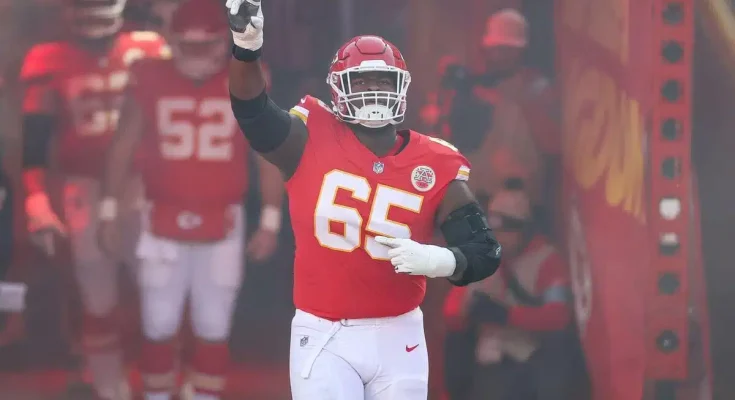The landscape of professional football, particularly the National Football League, is a dynamic ecosystem where athletic prowess meets shrewd financial strategy. Every offseason, the collective eyes of fans, analysts, and general managers alike turn to the delicate dance of contract negotiations. These discussions, often held behind closed doors and fraught with intricate details, determine not only the immediate future of individual players but also the long-term competitive viability of franchises. In this highly specialized world, the recent news emanating from Kansas City has sent ripples throughout the league: the Chiefs have reportedly agreed to a monumental four-year, $94 million extension with their Pro Bowl guard, Trey Smith, a deal that includes a staggering $70 million in guaranteed money. This isn’t merely a signing; it’s a statement, a testament to the value of foundational pieces in an era defined by explosive offenses and the paramount need to protect the game’s most valuable assets – the quarterbacks.
To truly appreciate the magnitude of this contract, one must first understand the intricate economics of the NFL. Unlike many other professional sports leagues, NFL contracts are rarely fully guaranteed. The “guaranteed money” figure is the true indicator of a team’s commitment to a player, representing the portion of the contract that the player is assured to receive, regardless of injury or performance. A $70 million guarantee for an offensive lineman, a position often overlooked in the glamour of touchdowns and highlight reels, is an emphatic declaration of faith and a significant investment in the stability of the Chiefs’ offensive line. This deal elevates Trey Smith to the very pinnacle of compensation for his position, making him the highest-paid guard in NFL history by average annual value ($23.5 million) and guaranteed money.
Trey Smith’s journey to this landmark contract is, in itself, an inspiring narrative. Drafted in the sixth round of the 2021 NFL Draft out of the University of Tennessee, Smith was a player whose immense talent was often overshadowed by significant medical concerns, specifically a history of blood clots. Many teams shied away, fearing the long-term health implications that could derail a promising career. However, the Kansas City Chiefs, under the astute leadership of General Manager Brett Veach and Head Coach Andy Reid, saw past the question marks and recognized the raw power, relentless drive, and inherent leadership qualities that Smith possessed. Their gamble has paid off handsomely.
From the moment he stepped onto an NFL field, Smith has been an anchor for the Chiefs’ offensive line. In an age where rookie offensive linemen often struggle to adapt to the speed and complexity of the professional game, Smith immediately became a starter at right guard. He demonstrated a rare combination of brute strength, quick processing, and an unwavering commitment to protecting his quarterback, Patrick Mahomes. His impact was immediate and profound, contributing significantly to the Chiefs’ offensive resurgence and their subsequent Super Bowl victories. Across his initial years in the league, Smith has been a picture of durability, consistently starting games and playing an incredibly high percentage of offensive snaps. This consistent presence, combined with his high level of play, has transformed him from a late-round draft pick into an indispensable cornerstone of the Chiefs’ dynasty.
The timing of this extension is also crucial. The Chiefs had previously placed the non-exclusive franchise tag on Smith, a mechanism that would have paid him a robust $23.4 million for the upcoming 2025 season if a long-term deal couldn’t be reached by the July 15th deadline. While the franchise tag is a significant payday for any player, it often leaves them feeling unsettled, desiring the long-term security and commitment that a multi-year contract provides. For the Chiefs, avoiding the one-year tag and securing Smith for the foreseeable future was a strategic imperative. It eliminates uncertainty, fosters continuity, and allows the team to plan its salary cap more effectively for future seasons. It also sends a clear message to other players within the organization: perform at a high level, and the Chiefs will reward you commensurately.
The art of offensive line play in the NFL is a nuanced ballet of power, precision, and synchronization. It is a unit that operates in relative anonymity compared to skill position players, yet its performance is arguably the most critical factor in a team’s offensive success. A dominant offensive line can dictate the tempo of a game, open running lanes for backs, and, most importantly, provide the precious seconds a quarterback needs to scan the field, make reads, and deliver accurate passes. For a quarterback of Patrick Mahomes’ caliber, who thrives on extending plays and making throws from various arm angles, the protection afforded by his offensive line is non-negotiable.
Trey Smith’s role as a right guard is particularly vital in the Chiefs’ scheme. Guards are often tasked with dealing with powerful interior defensive linemen, executing complex pulling schemes in the run game, and providing immediate pocket integrity in pass protection. Smith’s ability to consistently win these individual battles, whether it’s anchoring against a bull rush or sealing off a defender on a run play, has been a significant factor in the Chiefs’ sustained offensive dominance. His Pro Bowl selection in the 2024 season was a fitting recognition of his individual excellence and his critical contribution to the Chiefs’ continued success. It’s a testament to how far he’s come from the medical concerns that once threatened to derail his career before it truly began.
Beyond the immediate impact of his play, Smith also brings a significant “cultural impact” to the Chiefs locker room. General Manager Brett Veach himself has highlighted this aspect, recognizing that players like Smith, who embody grit, determination, and a team-first mentality, are invaluable in building and sustaining a championship culture. These intangible qualities, while not always quantifiable in statistics, contribute immensely to the cohesion and resilience of a roster, especially when navigating the pressures of deep playoff runs and Super Bowl aspirations.
This contract extension also provides interesting insights into the Chiefs’ overall philosophy regarding roster construction and financial management. In recent years, the Chiefs have demonstrated a clear willingness to invest heavily in their core players, particularly those who directly impact the performance of Patrick Mahomes. The extensions of Travis Kelce, Chris Jones, and now Trey Smith illustrate a commitment to retaining their foundational stars, even if it means making difficult decisions elsewhere on the roster. This strategy prioritizes continuity and elite talent at key positions, believing that these players are the indispensable building blocks for sustained contention. The decision to trade perennial All-Pro guard Joe Thuney to the Bears, creating cap space, further underscores the strategic intent to free up funds necessary to secure Smith long-term. While a tough decision, it highlights the clear prioritization of Smith within the Chiefs’ offensive line future.
The negotiation process itself likely involved a significant amount of back-and-forth, as is typical with contracts of this magnitude. Smith, betting on himself and his continued high level of play, had reportedly turned down a “very respectable” offer before the 2024 season. This calculated risk ultimately paid off for him, as the guard market continued to swell, and his stellar performance further cemented his value. The final agreement, which provides him with market-setting average annual value and record-breaking guaranteed money, is a testament to the perseverance of both the player and his representation, as well as the Chiefs’ understanding of the market and their unwavering belief in Smith’s future contributions. The immediate guarantee of $46.75 million, including a $17 million signing bonus, and the full guarantee of his third year by March 2026, showcases a commitment to significant upfront cash flow, a key demand for many NFL players. This structure means that by the end of the 2027 season, Smith will have earned $70.5 million in cash, effectively ensuring that the vast majority of his guaranteed money is paid out early in the deal.
Looking ahead, this contract solidifies a crucial piece of the Chiefs’ offensive line puzzle for the foreseeable future. With Creed Humphrey, another 2021 draft pick and a Pro Bowl center, also having received a market-setting extension (four years, $72 million), and other significant investments like Jawaan Taylor at right tackle ($20 million per year) and the recent first-round selection of Josh Simmons at left tackle, the Chiefs are clearly building a formidable and expensive offensive line. This concentration of resources is a deliberate strategy to ensure Mahomes remains upright and productive, allowing the Chiefs’ high-octane offense to continue to hum along. The investment in Smith, alongside these other linemen, signifies that the Chiefs are committed to dominating in the trenches, a non-negotiable aspect of their championship aspirations.
From an educational standpoint, Trey Smith’s contract offers several valuable lessons about the NFL’s business side. Firstly, it underscores the importance of guaranteed money as the true measure of a contract’s value. Secondly, it highlights the strategic use of the franchise tag as a negotiation tool, a temporary measure to retain a player while working towards a long-term solution. Thirdly, it illustrates the escalating market for premium offensive line talent, a trend driven by the league’s increasing emphasis on pass protection and the astronomical value of franchise quarterbacks. Teams are realizing that protecting their most valuable asset is worth every penny, and the rising salaries for offensive linemen reflect this paradigm shift. Finally, it exemplifies the power of a player betting on himself and performing at an elite level, ultimately maximizing their earning potential.
The implications of this deal extend beyond the Chiefs. It sets a new benchmark for guard contracts across the league, influencing future negotiations for other talented players at the position. General managers of other franchises will now have to factor in Smith’s $23.5 million average annual value and $70 million guaranteed when assessing their own guards’ value and planning their salary cap. This ripple effect is a constant feature of the NFL’s financial landscape, where each major contract signed helps to define the market for similar players.
In conclusion, the Kansas City Chiefs’ decision to sign Trey Smith to a four-year, $94 million extension with $70 million guaranteed is a move that resonates on multiple levels. It’s a testament to Smith’s remarkable journey from a medically flagged draft prospect to a Pro Bowl lineman and the highest-paid player at his position. It’s a strategic masterstroke by the Chiefs, ensuring the long-term protection of Patrick Mahomes and the continuity of their dominant offense. And it’s an educational case study in the complex world of NFL contracts, demonstrating the interplay of player performance, market dynamics, and calculated financial decisions that shape the destiny of professional football teams. This is more than just a contract; it’s a foundational piece laid for the future, a powerful statement of intent from a franchise determined to maintain its championship pedigree.



